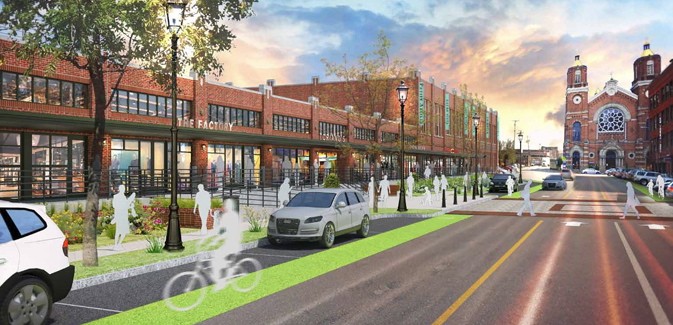Sustainable Cities Design Academy 15 | August 5 – 7, 2015
AAF’s Center for Design & the City is looking forward to its 15th Sustainable Cities Design Academy, to be held August 5 – 7 in Washington DC. During SCDA, teams from Las Vegas, NV; Milwaukee, WI; Pittsburgh, PA; and Wasco, CA will participate in a 2.5 day-long design charrette. These project teams will collaborate with a team of multi-disciplinary designers from a range of backgrounds to evaluate their projects, learn about relevant practices, and strengthen their capacity-building networks.
AAF’s charrette format prioritizes collaboration and information exchange between project teams and resource teams. During the charrettes, team members will collaborate with a wide range of professional experts, including architects, urban designers, and developers, to co-create solutions to their projects’ challenges. The private charrette format allows them to focus singularly on the project and learn about best practices in urban design, place-making, phased financing, and authentic community engagement practices.
Participants will also establish a wider social network of support, learning, and leadership from which to draw when faced with opportunities to design better places. SCDA 14 alum Glen Fulton, Executive Director of the Greater Englewood Community Development Corporation, said of his experience at SCDA, “This was spiritually uplifting for me. I can bring new hope back to our community.”
Las Vegas Cultural Corridor Connector

The Las Vegas teams plans to transform this swath of the U-95 corridor into a vibrant, arts-rich public space.
The Las Vegas team, composed of Michael Howe, Courtney Mooney, Gina Venglass, and Dianne Cripe of the City of Las Vegas and Rae Laethrop of Outside Las Vegas Foundation, plans to re-conceptualize a quarter-mile corridor of US-95 as a shaded public art trail way. This Las Vegas Cultural Corridor Connector project aims to connect nearby cultural facilities to the downtown core and Mob Museum area. The proposed site, which sits on 6.45 acres, is currently being utilized as surface parking. At SCDA, the Las Vegas team will connect with resource team members to focus more specifically on pedestrian connectivity and public place-making.
Milwaukee’s Harbor District Sustainable Development Plan

The Milwaukee waterfront holds the potential to brings together residential, commercial, and recreational uses, while preserving the existing natural habitats and industrial uses.
Milwaukee’s team is made up of Dan Adams from Harbor District, Inc.; Sam Leichtling from the City of Milwaukee’s Department of City Development; Jim Wasley from the University of Wisconsin—Milwaukee’s Institute for Ecological Design; David Misky from the City of Milwaukee’s Redevelopment Authority; and Nathan Guequierre from AECOM. The Harbor District Sustainable Development project aims to create a comprehensive development plan for the 1,000 acre Harbor District, located just south of downtown Milwaukee, where the Milwaukee, Kinnickinnic, and Menomonee rivers meet. Currently, the Harbor District is facing development pressure as surrounding neighborhoods like Walker’s Point—the fastest-growing neighborhood in the city—begin to reach capacity. The site spans 100 acres of large brownfield parcels, the new University of Wisconsin-Milwaukee School of Freshwater Sciences building, and the last 6 acres of wetland on the Milwaukee river.
Pittsburgh’s Smallman Street Produce Terminal
The Pittsburgh team is composed of Susheela Nemani-Stanger and Marty Kaminski from the Urban Redevelopment Authority, Ray Gastill from the City of Pittsburgh’s Department of City Planning, and Pamela Austin from McCafferty Interests. The Pittsburgh Smallman Street Produce Terminal project team is developing a plan for the approximately 125,478 square foot Smallman Street Produce Terminal and its surrounding area, which is located in Pittsburgh’s Strip District along Smallman Street, between 16th and 21st Streets. To date, none of the proposed plans for the building have addressed all of the sites issues and challenges. At SCDA, the Pittsburgh team hopes to gain clarity from the fresh perspectives of other attendees and from the resource team’s technical expertise during the charrette. Specifically, they hope to determine the best use(s) for the structure, and determine how to best implement place-making strategies that improve access to the nearby riverfront.
Wasco Farmworker Housing
Suzanne Hague of the California Strategic Growth Council, Pat Newman of Wasco Affordable Housing, and Roger Mobley and J. Paul Paris of the City of Wasco comprise the Wasco project team. The Wasco Farmworker Housing project plans to relocate almost 200 families currently residing in disconnected, industrially-zoned areas to a new, sustainably-designed public housing development. Their project aims to serve as a beacon of best practices in farmworker housing in the 21st century.
Follow the conversation on our social media channels during the session with the hashtag #SCDA15. To learn more about the upcoming session or to learn more information on the Sustainable Cities Design Academy, contact Center for Design and the City Director Elizabeth Okeke-Von Batten at [email protected].
Featured image courtesy of McCafferty Interests.




